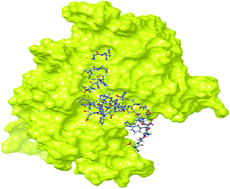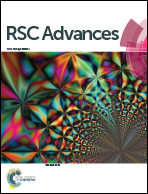Insight into molecular interactions of Aβ peptide and gelatinase from Enterococcus faecalis: a molecular modeling approach†
Abstract
Alzheimer's disease is characterized by the presence of extracellular deposition of amyloid beta (Aβ) peptides. The Aβ levels are maintained by a suitable balance between its production and clearance via receptor-mediated cellular uptake and direct enzymatic degradation. However, decreased production of Aβ degrading enzymes and loss of Aβ degrading activity in the human brain initiates the process of accumulation of Aβ peptides. Mutations in amyloid beta peptides are also known to reduce clearance of Aβ peptides. So it becomes necessary to understand molecular interactions involved in the process of Aβ degradation in detail at the atomic level. Hence, in this study, we used molecular docking and molecular dynamics simulation techniques to explore molecular interactions between gelatinase from Enterococcus faecalis and Aβ peptide. The comparison between wild type and mutant Aβ peptides revealed that the docked complex of gelatinase–wild type Aβ peptide is more stable as compared to mutant complex. These results showed that the residue Glu 328 of gelatinase from E. faecalis might play a catalytic role by serving as a proton shuttle to cleave wild type Aβ peptide in between Leu 34–Met 35. Thus, the results obtained from this study might be useful to design new strategies against Aβ peptide degradation.


 Please wait while we load your content...
Please wait while we load your content...